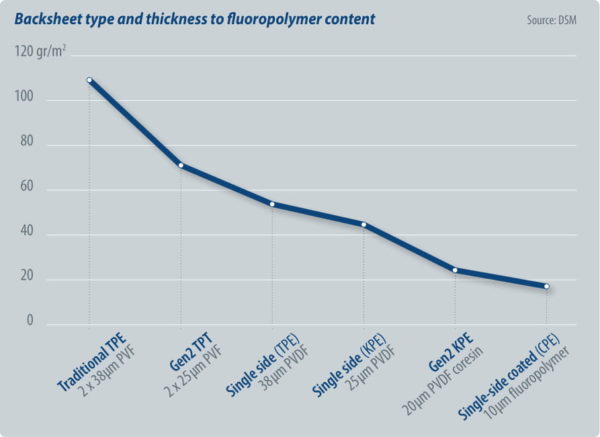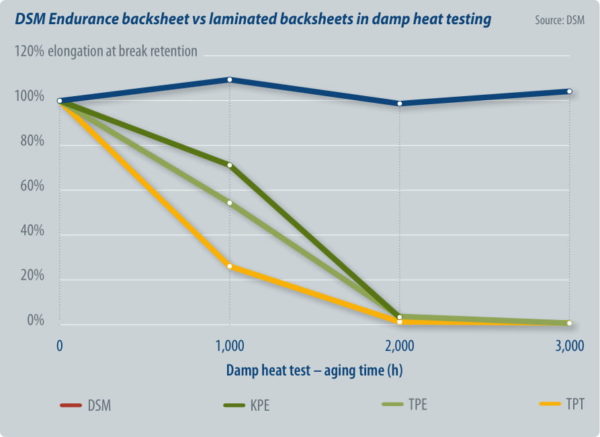From pv magazine, December edition
Backsheets are a critical component of a solar module, delivering three key benefits: enhanced durability, protection from the module’s electrical currents, and improved energy yield. For solar modules to perform according to industry regulations for over 25 years, backsheets must provide excellent weatherability, electrical insulation, reflectivity, mechanical strength, and adhesion to the encapsulant.
Traditionally, backsheets have been manufactured through a multi-layer lamination process in which prefabricated films are integrated using adhesive resins. Most commonly, a core layer of polyethylene terephthalate (PET), a low cost material not designed specifically for outdoor use, is sandwiched between two weather-resistant films, predominantly fluoropolymer-based. In this way, the PET delivers good electrical insulation, while protected by the outer layers against weather elements and ultraviolet (UV) light.
Despite a long service record, this backsheet design has been highlighted as an area for improvement. Multi-layered backsheets are prone to cracking and delamination, where moisture and organics can penetrate the module, resulting in sudden or gradual drops in performance. In addition, adhesives make the backsheets very difficult to separate and recycle, while use of fluoropolymers significantly increases the carbon and eco-footprint.
PV is marked by increasing competitiveness and cost pressure from end users. Improving product performance in these market conditions is extremely challenging. Fortunately though, the shift from module cost ($/Wp) to energy cost
($/kWh) has enabled DSM to leverage our scientific competences and innovate on performance instead of simply cutting cost. DSM has done so successfully in the field of cover glass coatings, and is now doing so in the field of backsheets.
The challenges of growth
Over the past decade, the PV market as a whole has experienced exponential growth, adding 99 GW of capacity in 2017 alone, according to SolarPower Europe. This outstrips all other sources of renewable energy, and market forecasts underline further strong growth ahead, with the International Renewable Energy Agency predicting PV will become a leading source of power, representing 22% of global electricity production by 2050, compared to 2% today.
The PV market’s strong growth over the past 10 years has been driven by cost reductions, making PV more competitive compared to fossil fuels. Backsheet has kept pace with overall module cost reductions, lowering its price over 60% in the past six years.
Where backsheets are concerned, manufacturers have often chosen to cut costs by compromising on quality. Costs have been cut by reducing layer thickness or introducing cheaper materials that do not perform as well. Fewer than 5% of modules today contain backsheets with the original quantity of fluoropolymer and can demonstrate the often claimed field performance of 20 years or more.
To support further growth, the industry needs to keep driving down the levelized cost of energy by improving durability, energy yield performance, and crucially, tackling the industry’s waste streams by enabling materials to be looped back into the supply chain as low cost feedstocks.
Alongside performance, there are end of life issues and use of hazardous materials to address. Laminated backsheets hinder a more circular approach, and will contribute to greater waste streams and environmental pollution.
We see now that the traditional multi-layered laminated or PET core layer-based backsheet has – by and large – reached its limit in terms of improvement potential. Further cost reductions are not possible without breaching the minimum performance limits, and the lack of control over base film composition complicates reaching ‘maximized’ performance.
A new solution for a new chapter

With these in mind, some manufacturers have looked to drive forward by producing multi-layered PV backsheets through a one step co-extrusion of thermoplastic materials as an alternative to lamination. In this process, commonly used in the food packaging material industry for example, two or more polymers are simultaneously extruded through a single die. As such, the polymers are joined together so that they create distinct, well-bonded layers forming a single extrusion product that does not require any adhesive.
DSM acquired backsheet developer Sunshine in 2016, and has built on its technology to develop a convincing solution: the co-extruded Endurance backsheet which, along with other suppliers such as Bischof + Klein and Tomark Worthen, can enable the industry to achieve a step change in performance and sustainability.
“Our Endurance backsheet is produced through a solvent-free and cost effective manufacturing process,” says Kurt Van Durme, Application Development Manager Europe, DSM Advanced Solar. “As we do not use cross-linking adhesives and fluoropolymers, which are difficult to melt, 100% of the trim-edge production waste is recycled, while the backsheet can be recycled at the end of the module’s operational life. As such, our Endurance backsheet will help drive the circularity of the photovoltaics industry.”
Giving full control over all polymer formulations in the backsheet composition, the co-extrusion manufacturing process enables DSM to design products better tailored to the application. Unlike other types of backsheet, which can become brittle due to hydrolysis of the PET core layer, DSM’s proposition offers good hydrolysis resistance even at high temperatures. As such, Endurance backsheets can easily be put to work in hot and humid climates, as well as in floating solar parks.
A tried and tested proposition
As with all innovations in PV, co-extruded backsheets have had to undergo a thorough validation process before being brought to market. Technologies have to prove their 25 year performance capability through accelerated testing, as well as ease of use by module makers.
Before fully commercializing its Endurance backsheet, DSM conducted field tests in collaboration with leading research institutes and third parties across the value chain. “For over two years, we tested our Endurance backsheet with a range of partners in different locations and in different environments, including Pune in India, which has a hot and humid climate,” says Milica Mrcarica, Application Development Specialist, DSM Advanced Solar. “Today, the oldest modules in the field with our co-extruded backsheet have surpassed the critical five year period without any sign of failure.”
In these tests, the Endurance backsheets show optical reflection of more than 90%, superior durability and UV performance, strong resistance to sandblasting, and an effective barrier against moisture. The independent module accelerated sequential testing (MAST) carried out by DNV GL showed that the backsheet performs very well in harsh outdoor conditions, and was in fact the only non fluoro-based backsheet to pass the test. It goes to show that, provided you choose your materials well, co-extrusion will lead to excellent interlayer adhesion and durability.
The Endurance backsheet is easy to process – experienced tier 1 module makers have shown that they do not need to make special adjustments. In cases where manufacturers do face initial challenges, these can easily be overcome with help from experts at DSM, who draw on our global presence and more than 100 year track record in materials science.

Looking ahead
In view of the results of the tests carried out so far, this technology promises to pave the way for further industry developments and progress. We’re very proud to have helped develop this technology. It will open up new horizons for an industry that will be crucial in meeting the United Nations Sustainable Development Goals (SDGs) – especially the 12th goal, which is to ensure responsible consumption and production. The time is right for parties across the value chain to take responsibility and move toward more sustainable and circular solutions, like our Endurance backsheet.
While we’re very confident in our value proposition, we will continue to work on this technology in line with market demands and the feedback of our partners. In particular, in 2019, we hope to continue developing the aesthetic scope of our Endurance backsheet, and broaden our product portfolio, such as by launching our highly reflective black backsheet. These developments will help with the market uptake of this technology.
Imco Goudswaard
This content is protected by copyright and may not be reused. If you want to cooperate with us and would like to reuse some of our content, please contact: editors@pv-magazine.com.








Very Good article on DSM’s Co-Extrusion Process 7 it’s advantages in Reliability & Performance.
However, there seems to be a typo error in the Graph “DSM Endurance Backsheet vs Laminated Backsheets in Damp Heat Testing”.
The Performance Curve description for DSM Backsheet is indicated by Red color, but, there is no Red color Performance Curve in the Graph. Perhaps, DSM Backsheet Curve is shown in Dark Blue Color.